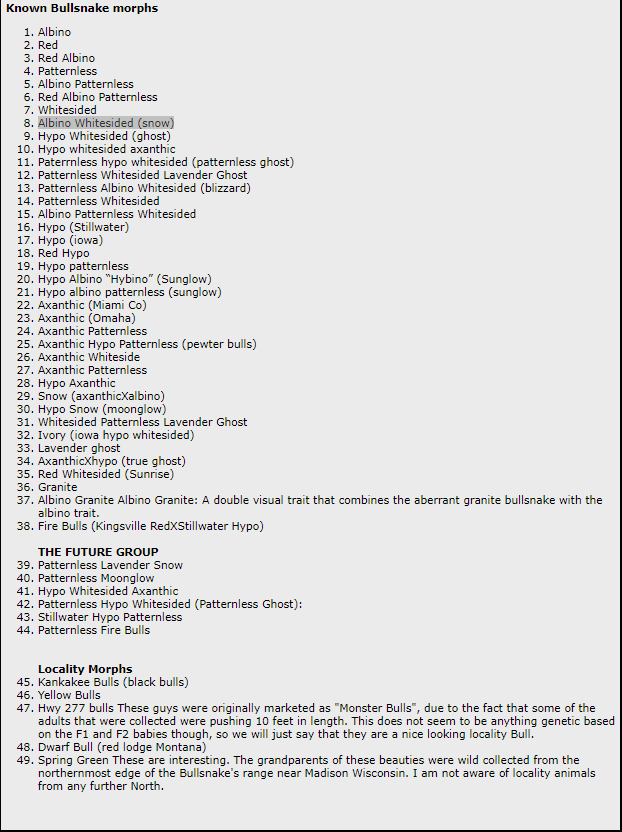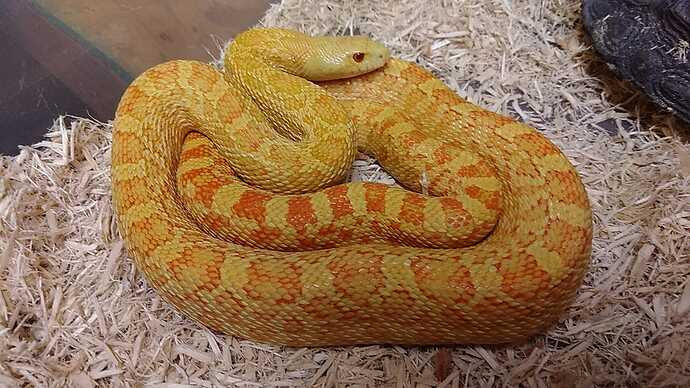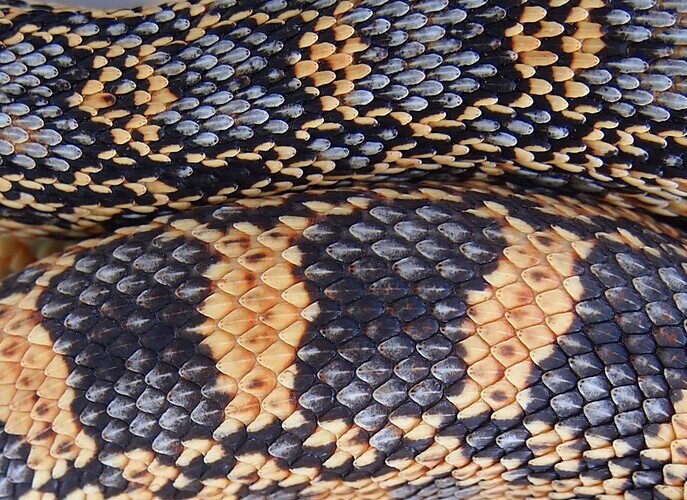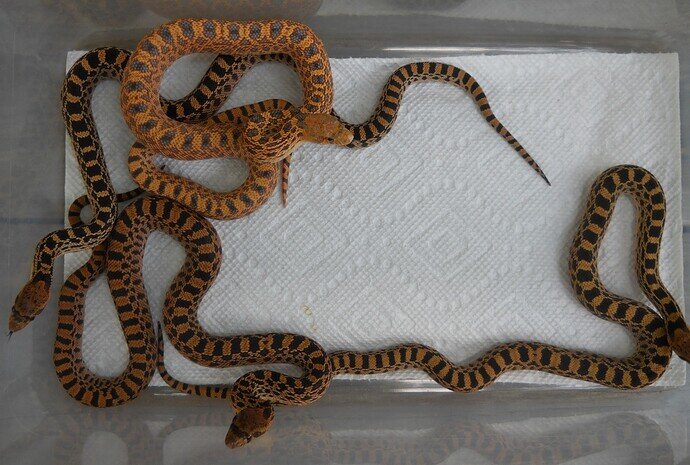It’s a locality from Texas that has been line bred to make super red bullsnakes.
We also need to define what trait does what to head, body & tail.
I wonder if this would be the same as a Crumble?
Welcome Fairy
It very well could be
I know a couple folks that can likely help out. I will ping them this evening
Isnt an albino/whiteside a snow?
Crumbles/
Lemon Drops
Flames
Lets gets this goin folks, the sooner we get the info the sooner we can get all this corrected and all headed in the right direction!
For Pits I dont think folks stayed in their lane when breeding and naming morphs?
Lemon Drops to my knowledge is a stillwater hypo albino that has been line bred for a high yellow w/ a very low pattern.
Lemon drop example:
Photo from: John Skager
Crumbly/crumbles same as above, line bred for a bright red and I believe that they are from the Trumbower line.
Photo John Skager
As for the Flames dbl het line bred red

Photo John Skager
There is also Hannum Hypos that are From the Stillwater line and they have blue saddles when they are born and the real nice ones keep the bluish grey saddles. John Hannum has been working on this to try and figure out what exactly he has (I think he has been at it for over 5yrs.) This was a complete surprise, as they were purchased from Envy Reptiles (Jason), grown up, bred and thats what came out and no one really knows how or why? (Main reason is, not keeping good records of whats what and whom you put with whom?)
Here are a few pics to help see what I talking about.
Close photo John Hannum
Just look at this male high blue saddles:
Photo John Hannum
There is another version of this morph, however there only happens to be one of them currently for the last few years. The other morph version is the same except you would replace the bright orange for a bright yellow. I have only seen a picture of it once and Jason from Envy had produced it once again but did not realize what he had until it was too late. He ended up having to buy back some of his hatchlings and has yet been able to reproduce said morph. Jason calls his yellow version digitized because thats what it reminds him of. Hopefully some day we will have an opportunity to own such animal.
Hopefully some others chime in…
PS thanks for working on this!!
Not terribly on topic, but what’s the reasoning behind not promoting gophersnakes too, given they are the same species as bull snakes?
Thank you for helping so much!
We are working in order of popularity in terms of listings, but we plan to cover as many species as possible eventually ![]()
After making my last post on here, I thought I would try and find out all I could find out about Envy’s (Jason) digitized pit. It turns out I was mistaken on its linage, this particular animal is from the Trumbower Hypo line and not Stillwater Hypo I originally thought. Jason was breeding in one of his red lines and this is another morph that Jason had to buy back his own stock because they didnt start showing these colors until a few sheds in. I also managed to find this pic. She is an absolute stunner! You can just see her blue/grey saddles and bright yellow back ground!!
Photo Jason (Envy)
@mylife Thank you so much for your help with this!!
I have a few questions:
So a line bred Red + Albino + Stillwater Hypo?
I’m confused on your wording of this one.
What is it double het for, and I take it whatever it is is allelic?
For the crumbles in my original post I had stated they were Stillwater but I think John told me Trumbower.
The red + albino + SW hypo is what started the project. Then line bred.
I am not sure how much I am or can be but I will do what I can to help the section of the hobby as it desperately needs!! And Thank You for all your help and what you do on here!!
Anyway line bred would be to take the best looking, best pattern, brightest color, etc. and breed together to make even better looking, better pattern, brighter color, etc. So what I was saying is they are most likely dbl, triple or even quad hets pending how many times bred etc.
PS: I have been in touch with John Hannum and have asked if would give his input on his Hannum Hypos. He said he would try. I sent him a link to this category.
Will also need to add both Tiger and Zipper since these are becoming more common. Tiger is a recessive trait. I can’t speak for Zipper but my understanding is it is more of a line bred trait. As for some of the combo names, it seems they change depending on who you ask. Could be difficult to pin down exactly what the combo consists of, especially with snows or blizzards.
From my personal understanding,
Ivory= hypo Whiteside (either hypo line)
Snow= axanthic albino
Ice= hypo snow
I’ve heard blizzard go multiple ways of being
Hypo snow whiteside
Or
hypo snow whiteside patternless
Or
Hypo snow patternless
The difficult thing is when you have a white snake its hard to tell exactly what’s involved unless the genetics are guaranteed. I believe the blizzard is supposed to be all 5 genes though. Hypo Snow Whiteside patternless.
I think it would be best to get Jason Nelson at Envy reptiles involved and get his input on all of it for the combo titles. Otherwise it may be best to just keep it at the basic morph names instead of using combo names.
The “digitized pit” pictured above is a female I produced in 2018 and sent to Jason. I sent him a male in 2015 so he could try to fish out the het in his other females but, as far as I know, he was unable to find who the carrier was for a trickle through gene.
I produced the first of these odd blue saddled bulls in 2014 from pairing a red het albino to a red albino - both from Jason’s(Envy Reptiles) red albino project. Turns out these animals were unknown carriers for a hypo gene. With my limited resources, I’ve mostly left the figuring it out to other folks. I bought in what were supposed to be Trumbower hypo carriers to test breed but those results didn’t pan out - or were inconclusive at best. I’ve produced them every year since 2014 but, to this date, have only held back 3 single gene visuals for myself and future breeding stock.
I went years calling these simply “red hypos” since the origin of the hypo gene was unknown. As I mentioned, I bought a couple Trumbower hypo carriers to test breed but failed to produced visuals with decent numbers(over 30) snakes produced from pairing my visual hypos to hets so I felt fairly confident saying they “definitely” weren’t Trumbower… Then last year a friend, Tani Argonza, produces visual hypos pairing one of my hets to a visual Trumbower. I trust Tani’s results over my own since he used a single gene visual Trumbower in his trial. Anway, I’m back to calling mine “red hypos” for the most part since I’m tired of being wrong, haha. Whether they’re truly a trickle through Trumbower hypo or something entirely new that happens to be allelic, I couldn’t tell you. I do know they are fairly unique looking and, last I heard from Jason, he hadn’t been able to replicate the look when pairing either of the 2 I sent him back into his original red albino line critters.
Hey John!! First of all Welcome!! Thank you very much for coming in here and letting us your results as well as your findings and thoughts with this line of Pituophis I really appreciate your input!!
Hello, my friend John Hannum had reached out to me about a list of morphs and localities you’re all trying to put together and wanted to see if could be of help. My son and I, Angel Argonza had worked with every gene available and almost every combo created, including several localities. I myself have been working with Pituophis for over 2 decades now. Though mainly my focus has always been with Melanoluecus. Over the years there has been a lot of confusion with bullsnake genetics and common morph names. It was agreed upon several years ago to do away with these morph names and list each morph by visual representation. Due to the fact that a lot of morph names were created when only a handful of genes were available. Here is one example, snow bull = whitesided albino. This was back when it was thought the whitesided gene was a true anery due to how it cancels out some but not all background color. It wasn’t long that the Omaha axanthic strain was discovered and then the Miami Co by John Cherry. Eventually a true snow was created and dubbed a lavender snow. With online information, and no books written on these genetics, it has been hard to avoid bringing back these old habits with newcomers to the species. So how I list my snakes : Lavender Ghost aka true ghost/Stillwater X Miami Co Axanthic. Listing the genetics is more important due to the fact that there are several albinos, 2 known recessive hypos, 2 axanthics, and 2 whitesided. Only the 2 whitesided genes are allelic. So it’s be a better practice to list what you have visually by each gene represented.
Now I remember a gentleman named John Mara(forgive me for misspelling) had created a full updated list of all genetics pinned at the top of the Pituophis Enthusiasts page on FB. Which many breeders including my son and I had helped to put together. What you will not find however are the common morphs names next to them as to do away with that practice. But I, myself find it hard to get away from it as this is what newcomers use as reference to identify each morph combo. As much as Dav’s list holds true to most of the genes available and combos made, some of the info is inaccurate. IE, Kingsville Red X Stillwater is not a firebull. But a Trumbower Hypo X Kingsville or Crumbly Red. A Stillwater X Kingsville Red or Crumbly Red was known as a “Flame Bull”. Coined by the man who made popular and also brought both the Kingsville TX locale line and erythrism from that line, along the Stillwater hypo into the hobby, John Ginter. Another erythiristic gene used is from Amarillo lines and of course the famous Crumbly bulls aka Crumbly reds made famous by Scott Crumbly. I believe that is the line being referred to on this thread as “crumbles.” It’s called a “Crumbly red”. I’ve worked with all these lines since I started with Pituophis and still do to this day. Lets try and clear things up some so here is a list of known available genes:
There’s are 3 known albinos and have proven to be incompatible. Though one hasn’t really been tested with the others as its fairly new.
1.Craig Trumbower aka Lubbuck TX line
2.Dav Kaufman’s aka Amarillo TX line
3.A new one discovered by Joseph Forks from TX locale just a few years ago(not to be confused with his SonoranGopher gene known as the Forks gene)
2 Axanthics strains and both are incompatible
1.Miami Co aka Silver bulls discovered by John Cherry
2.Omaha Axanthic aka Gary Ballum line(which came out of the original “Speckled Bull” which is now known as the “patternless gene”.
2 Whitesided strains and are the only ones that are allelic
1.Trumbower strain(clean white wall sides)
2.Gary Ballum strain(speckled sides)
Several Erythristic and all are polygenic coming from several TX lines. I will list the ones I’ve worked with
1.John Ginter’s Kingsville TX
2.Scort Cumbly’s Red (I had just recently met Scott in person and finally got the history on this line. It’s unknown locale and he had purchased the founders from a Maryland expo decades ago)
3.Amarillo TX
One Xanthic gene
1.Envy Reptiles Yellow bull lines(originated from F1 South TX bulls. I had Jason Nelsons founding pair. Massive 7ft bulls.)
One Patternless gene
1.Omaha Pattarnless aka Omaha Speckled bull and now known as “patternless bull”
2 Tiger genes
1.The original comes from John Ginter’s Kingsville TX line and is inherited by line breeding or inbreeding. Basically a polygenic trait, first dubbed by KJ Lodriguez. Named after his home town baseball team in Louisiana. This is also what is now being called a zipper. It’s actually been around a while and commonly found within wild caught populations. I’ve worked with this original line. Can also be seen in some red bull lines like John Hannums reds.
2. Zipper by John Skager. Created by selective breeding bulls with high blotch counts. Im now starting to see it in kater generations of my Stillwater/Kingsville red/Miami Co, Lavender Ghost line.
2 Recessive hypos and both are incompatible
1.Stillwater hypo discovered by Adam Marty and spread though the hobby by John Ginter
2. Trumbower hypo first produced by Craig Trumbower in his efforts to try and produce the first “snow bull” combo. Now this gene is very variable.
The Trumbower hypo is variable even within each clutch alone. I can prove that with 2 sibling hypos I had from old Trumbower lines. These were never crossed with any other lines. The default color can effect how the gene will look visually eapecially with amount of melanism within the default color. Due to this many breeders have produced different variants and had thought they had a new gene. Called everything from T Pos bulls, Caramel bulls, Raspberry bulls, and now Hannum hypo. Which I’ve proved out this year is just a red variant and have been able to replicate it outcrossing to an old Trumbower line holding only 3 of the original Trumbower genes. I believe other test from breeders to be inconclusive due to their lines have high possibility of having both hypo genes. As many breeders in oast had started combining these lines unkowing that the hypos were incompatible. The original pairing of Jason Nelson’s albino reds was a Kingsville Red X Trumbower albino by John Ginter. Any Trumbower gene will have the possibility of passing either a whitesided or hypo from Trumbower’s line. In this case the hypo manifested within John Hannums group. Any or anyone that works with Jonel Lopez line have a possibility of carrying both hypos, though he mainly worked with the Stillwater hypo. I had Jonel’s original trio that founded his multi gene line. Which is why test with this line can yeild inconclusive results with the hypos from John Hannums stock. Anyone looking to get more info on my test results on this line, you can find it on Bullsnake group or Pituophis Enthusiasts group.
There are also natural hypos like one within John Ginter’s Kingsville red line. Though no test has been done on it, but several in each clutch from John’s locale line will yeild offspring that will produce little to not melanin. Rather replaced by maroon to dark purple like blotches on the posterior area. Bulls within the southern part of their range in TX can be found with little melanin.
Hope this helps clear up a lot of questions on bullsnake genetics.
Tani Argonza
@john_hannum @summerssnakes @mylife
Wow you guys wouldn’t understand how much this is appreciated
This may be one of the best posts ever made on this forum @oldcityserpents
Thank you so much for all of this!!!






